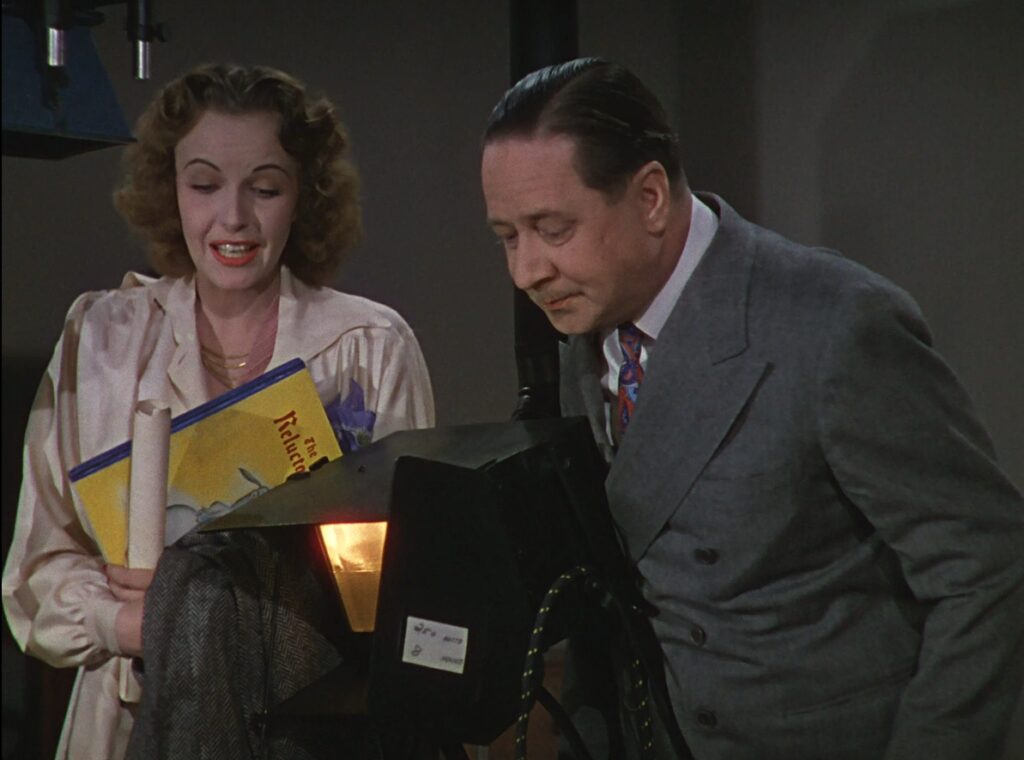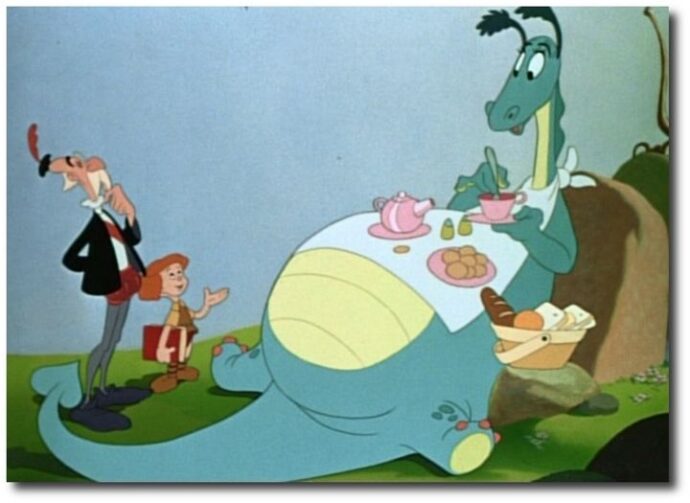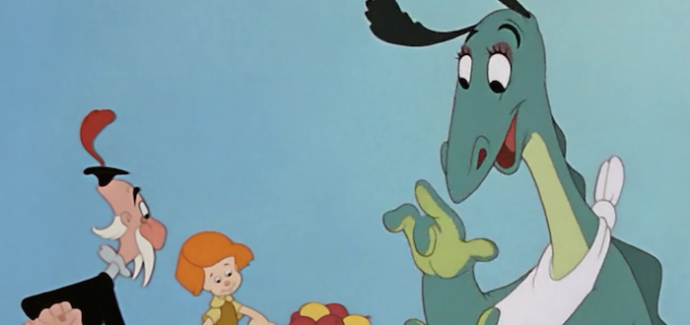Plus or Minus is a series detailing and analyzing every feature film now streaming on Disney+. It combines the unique history all these films share, their cultural impacts, and their qualities, or lack thereof. From timeless classics, to acquired hits, to DCOMs, no stone will be left unturned.
So far, this series has mainly focused on Disney’s animated offerings. This next iteration of Plus or Minus, focusing on 1941’s The Reluctant Dragon, is a bit different. Technically, Reluctant Dragon serves as Walt Disney’s first live-action feature. However, it’s debatable to really call it that.
Instead of a traditional narrative, this serves more as a tour of Disney Studios and how they make their animated productions. While an animated short titled “The Reluctant Dragon” appears at the end, it’s mainly an avenue for Disney to showcase his then-new Walt Disney Studios. In a way, it was a precursor to the Disneyland and Wonderful World of Disney television series, which served as commercials and behind-the-scenes ventures for upcoming Disney products.
How Did It Come to Be?
The question of course is this: why make the film? Why not make this a traditional animated film? Simply put, Walt Disney wanted to show off his new workplace. The success of Mickey Mouse and Snow White made the general public more intrigued with animation. How do animators make these characters come to life? How does the process work? By giving this behind-the-scenes peek, Walt got to showcase his new studio and show people how the sausage gets made.
But, sadly, the main reason is to distract from the Disney animators’ strike in 1941. Walt Disney, known for his anti-union stances, was not seen in a favorable light by many of his employees. Pay inequity and an unfair hierarchy system. Disney also being against his company being a part of the Screen Cartoonists Guild also drew ire from his employees, prompting a strike during production of Dumbo that same year.
This led to Reluctant Dragon’s creation, serving as a whitewashed showcase of Walt Disney Studios and a distraction from what was actually going on. Some of the animators showcased were actors, and the happy family Disney supposedly pushes was all just a facade.
A bit of a tough pill to swallow, but I’ll discuss that in more detail later.
The Host
Despite being named for an animated segment, The Reluctant Dragon’s main crux is its live-action tour, hosted by Robert Benchley. For those who don’t know, Benchley was a famous humorist, writing for publications like Vanity Fair and The New Yorker. Benchley was also a part of the Algonquin Round Table, a group of New York city writers, critics, and actors who engaged in daily luncheons, back in the 1920s. These luncheons saw the group take part in humorous conversations then spread across the country to avid readers. Members included Irving Berlin, Dorothy Parker, Harold Ross, and Alexander Woolcott. Even Harpo Marx was an associate. But as the members moved away, the Round Table began to drift.
Since then, Benchley went on to become a filmmaker, working on several short films, including the Oscar-winning “How to Sleep”. As an actor, he would have bit parts in several feature films from RKO and MGM, including The Gay Divorcee and The Broadway Melody of 1938. He was arguably a name talent, though it’s a stretch to say he was the superstar the film somewhat hypes him up as. Still, he has enough of a solid presence that makes him the perfect audience surrogate for the film itself.

The Tour
The premise to Reluctant Dragon is flimsy at best. Benchley’s wife feels the Kenneth Grahame children’s book of the same name would be perfect for a movie. Therefore, they go off to meet Walt Disney at his new studio to sell the rights. From there, Benchley tries to avoid an obnoxious studio guide that’s always one step behind him, inadvertently stumbling on the many operations of the studio.
It’s a very lame set-up, and moments that focus on the “plot” are pretty corny. With that said, what helps these segments are the actual operations. Of course, this is uncomfortable when including the historical context. However, there’s still something special seeing Disney animators, albeit ones who sided with Walt during the strike, do their thing.
Every moment is memorable and serves as an interesting look at the forming and developing of animation. Every facet, from designs to storyboards, is showcased and there’s something special, even if romanticized, seeing the medium come to life. Some of the particular highlights are the voice recording segments, including Donald Duck’s voice actor Clarence Nash, and the maquette segment, featuring early character designs for Peter Pan.
The Other Cartoons
Before getting to the title animated segment, there are other animated shorts to pad out the running time. Three to be exact. The first is a very simple black and white short focusing on the train Casey Jr. from Dumbo. It’s cute, but it’s very short and is really only there as an excuse to show the foley segment.
Next up is “Baby Weems.” Being a part of the storyboard segment of the film, this is more an animatic than an animated piece. There’s little actual animation, apart from a few limited movements, but it’s not very distracting. Its story seems clever at first. A newborn baby who has a powerful brain that allows him to speak and spar with the greatest minds. All the while, Weems’ parents can’t see their son because of all the press getting in the way.
The character designs are memorable, and it’s paced relatively well. At the same time, it’s not really the most interesting story. The concept has potential, but it goes into predictable beats that don’t leave much to the imagination. And while the storyboards aren’t awful, being fully animated probably would have given some energy to the piece.
Immediately after was the Goofy short “How to Ride a Horse”. Interesting fact here is this was the first of many “How to” shorts starring Goofy. As somebody who’s favorite character in the Disney roster is Goofy, I had a blast here. The slapstick is fantastic, the dry narration is funny, and it’s a very simple premise the team takes full advantage of. Having said all that, these both are more filler shorts for the supposed main event.
The Reluctant Dragon
Took a while to get here, huh? Despite being called The Reluctant Dragon, the actual animated featurette serves as the finale to the film. Its premise is a simple one. A dragon is nearby a village, causing panic in the town. A young boy then sets out to see the dragon for himself. However, instead of a ferocious beast, the dragon is a shy, flamboyant, poetry-loving creature without a fighting bone in its body. The boy and the dragon become friends, but soon the boy has to convince Sir Giles, a knight sent to slay the dragon, to befriend the dragon and keep him alive.
The one interesting element of this animated segment is the dragon itself. It’s flamboyant mannerisms makes it as queer-coded as one can get, and it’s oddly interesting to see. Not just because the animators clearly have fun with his movements, but how oddly tasteful the dragon is. At least, for 1941.
There’s definitely a play into stereotypes, which does not especially make this age perfectly. Yet at the same time, the film celebrates the dragon for not being interested in fighting. His pacifistic nature among other attributes are celebrated and respected. It’s kind of interesting and while likely not intentional is mildly progressive for family fare.

But that’s really the only standout here. The plot is fine, the climax is cute, and the animation is solid, but there’s nothing truly memorable here. It goes through the motions and acts as a cute little segment. This would be a bit more acceptable as its own thing, but as the big finale to a feature film, it’s just kind of average.
Plus or Minus?
Choosing Plus or Minus for The Reluctant Dragon is a tough one. On the one hand, Reluctant Dragon romanticizes the studio, hides the true horrors of its studio, and none of the animated pieces are especially memorable. Yet it’s still exciting to see animation come to life and there’s a corny charm that carries it through.
Yet in the end, there’s still something shady about the film’s behind the scenes that still make it hard to ignore. It’s a mild Minus, but still a Minus all the same.
Next time: Reluctant Dragon features a brief sneak peek at the next animated piece Dumbo. Is the story of an elephant with big ears a Plus or Minus?
